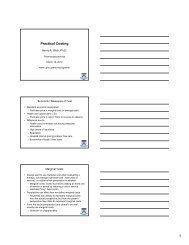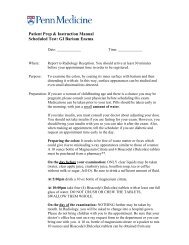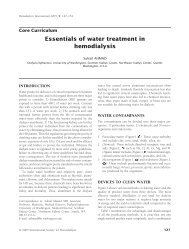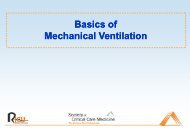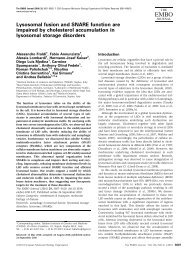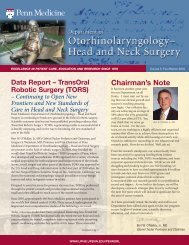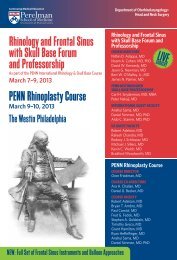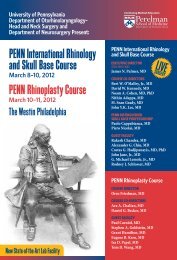Staging Laparoscopy with Laparoscopic Ultrasonography ...
Staging Laparoscopy with Laparoscopic Ultrasonography ...
Staging Laparoscopy with Laparoscopic Ultrasonography ...
Create successful ePaper yourself
Turn your PDF publications into a flip-book with our unique Google optimized e-Paper software.
PancreatitisCharles M. Vollmer, Jr., M.D.Associate Professor of SurgeryDirector of Pancreatic SurgeryUniversity of PennsylvaniaSurgery 200 CurriculumMarch 15, 2013
What is Pancreatitis?
Pancreatitis
The Burden of Pancreatitis• Incidence: 80/100,000/year• 250,000 admissions per year for acute pancreatitis• 1.7 billion for hospital facility costs• 250 million/year in loss productivity due to patienthospitalization• Mortality in severe disease (SAP) has remainedhigh for over 30 years.
Classification of PancreatitisAcuteAcute inflammationAcute abdominal painElevated serum pancreatic enzymesSelf-limitingChronicChronic inflammationChronic abdominal painProgressive loss ofpancreatic endocrine andexocrine function
Definition and PathogenesisAP may be defined as an acute inflammatory processof the pancreas <strong>with</strong> associated serologic andclinical criteriaExact mechanism is unknownEarly events:‣Inability to secrete pancreatic zymogens‣Early activation of pancreatic enzymes
Mechanisms ofAcute Pancreatitis• Reflux theory: Bile reflux up the pancreatic ductactivates trypsinogen. Postulate interstitial (asopposed to intracellular) trypsin leads topancreatitis.• Co-localization theory: Missorting of digestiveenzymes and lysosomal enzymes <strong>with</strong>in the acinarcell. Lysosomal enzymes, e.g. cathepsin B,prematurely activates trypsinogen to trypsin thusactivating the cascade
Pathogenesis of Acute Pancreatitis4Blockade ofsecretion?protein pluggallstone sludge33aenterokinaseortrypsinTrypsinCellularDestructionPrematureactivationEarly release51 – antitrypsin2 - microglobulinlysosomesFusion oflysosomes andzymogensEarlyRelease2aPSTICathepsin B1GolgiComplexcvcvcv2ZymogengranulesNucleusRER
Etiology• Alcohol• Gallstones• ERCP induced• Ideopathic• Hereditary Pancreatitis• Hyperlipidemia• Pancreas Divisum• Medications (Thiazides, Valproic Acid, Azothiaprine)• HIV• Mass effect (tumor, diverticula)• Hypercalcemia
Patient ScenarioA 60 year old 275 pound man presents to the emergencyroom <strong>with</strong> abdominal pain. While entertaining friends thenight before, he developed a sharp, stabbing epigastric painacutely an hour after eating BBQ pork. Eventually the painradiated to the back and did not subside, prompting a visitto the ER early in the AM where he developed nausea,vomiting and generalized malaise. He has not defecatedsince but had voided a scant amount of tea-colored urine.He has not had any fever or chills. He does note that he hashad upper abdominal pain in the past, just not to the extentthat he sought medical advice.
What Now?What is the differential?What is the etiology?How do you prove your diagnosis?How do you treat this man?
Manifestations of AcutePancreatitis• Pain is always present.• Peritoneal signs are absent - retroperitoneal organ.• Ileus may arise secondary to extension into smallintestinal and colonic mesentary.• Nausea/Vomiting.• Fever to 101 o F.• Hypocalcemia - rarely see tetany.• CBD compression, gastritis, duodenitis, pulmonarymanifestations.
Clinical FeaturesSigns and Symptoms Labs Differential DiagnosisAbdominal painLeukocytosisCholedocholithiasisAbdominal tendernessHyperamylasemiaPerforated ulcerFeverHyperlipasemiaMesenteric ischemiaTachycardiaIntestinal obstructionSalpingitis/ectopicpregancy
Ranson’s Criteria• On Admission– Age > 55– WBC > 16,000– Glucose >200– LDH > 350– AST > 120• During First 48 Hours– HCT Decrease > 10%– BUN Increase > 5– Calcium < 8– Arterial O2 4– Fluid Sequestration > 6L
Mortality and Ranson’s CriteriaRanson et al. Am J Gastro 77:633-638, 1982
Treatment of AP:Severity stratification• Risk factors predictive of severe disease:• BMI>30:• Hematocrit > 44 on presentation or non- decreasingafter 24 hours hydration• Organ Failure: Atlanta Criteria• Apache II >8• Radiographic Stratification– Balthazar CT Criteria– MRI
Change in Plans8 hours later….The patient is agitated, cotton-mouthed,short of breath, tachycardic and has made40 ccs of urine since admission. His pain isgetting worse.
How are you going totreat him?
Basic TenentsFluidsEnd organ supportNutritionPain controlInfectious control
HD Day 3• WBC 20,000• Bilirubin 3.8• Alkaline Phosphatase 300• Amylase 5200, Lipase 9800• Temperature 103 degrees• Requires vasopressor support
What’s the diagnosis?
Will ERCP help?
Indications for BiliarySphincterotomy• Severe pancreatitis – organ failure• Ascending cholangitis• Persistent biliary obstruction• Poor candidate for cholecystectomy• Post-cholecystectomy
HD #8• ICU• Intubated• Febrile 102 degrees• WBC 13,000• Otherwise stable
Why is he still febrile?
Capillaries and Veins WBC chemotaxis DICKallikrein Complement ThrombinTrypsinLipaseFat necrosis
HD # 15• WBC 25,000 and rising• Platelets 54,000• Febrile 103 degrees• Labile hemodynamics
A New Headache
Infection• Pneumonia• Line Sepsis• Abscess
Pancreatic InfectionsOnly occurs in 5% of acute pancreatitis(80% Deaths)Rare in interstitial (edematous) pancreatitisMajority occur in setting of necrotizingvariantTypes:‣ Infected pseudocyst‣ Pancreatic abscess‣ Infected pancreatic necrosis
Pancreatic NecrosisDiffuse or focal areas of non-viable pancreaticparenchyma, which is typically associated<strong>with</strong> peripancreatic fluid and inflammation
Pancreatic Necrosis
Sterile Necrosis:Operative Indications• To perform a STAT autopsy!• Demise is attributed to MSOF from the inception• Allow for delineation of viable parenchyma over time• Low mortality if avoided (< 2%)• Ventillator/ICU dependant over one month• Severe protracted pain, obstruction, or anorexia
Is this infected?How do we know?
Clinical Signs of InfectedNecrosis• Fever past first week of onset of pancreatitis• Increased leukocytosis• Thrombocytopenia• Metabolic acidosis• Shock, capillary leak, tachycardia• Deterioration of renal and pulmonary functions• Persistant ileus
What about this?
Abscess
How Do You Treat This?
Rational of SurgicalManagementRemove vaso-active and toxic substances that accountfor multiorgan failure originating in devitalizedpancreatic tissue and ascitesPrevent ultimate septic sequelae from infected necrotictissuePreserve viable pancreatic tissue as this has a majorimpact on long-term functional results
Indications for Surgery• Infected necrosis: No role for medical management.Universally lethal• Non-surgical interventions: More likely to resolvewalled-off collections like infected pseudocysts ordiscrete pancreatic abscesses• Operative approaches: Necessary due to particulatecomposition of necrotic collections• Sterile necrosis: No benefit in survival or improvementof associated organ failure
HD # 25Why is he still in the ICU?
Cytokines in Acute PancreatitisIntracellular Events Local Inflammation Systemic Inflammation(Trypsin activation) (IL-1, TNF, PAF produced (Amplification of local effect)in the pancreas. Tissue levels Cytokines activated via livercorrelate <strong>with</strong> severity) kupfer cells and producedin affected organs such aslungMultiorgan failureDeath
MSOF• Pulmonary• Renal• Cardiovascular• GI• Infection• Rehabilitation
Pancreatic Pseudocyst
Pancreatic Pseudocyst
Three years later…The patient is unemployed and has taken to the bottlefor the last few years.He presents to the BIDMC ER <strong>with</strong> debilitatingabdominal and back pain.Labs are significant only for a bilirubin of 2.6. Theamylase and lipase are normal. WBC: 11,000
Chronic Pancreatitis
Etiology of ChronicPancreatitis• Develops after attacks of relapsing acutepancreatitis• Interstitial acinar and fatty tissue necrosisresults inducing perilobular fibrosis• This causes stenosis and dilatation of themain and secondary pancreatic ducts• Protein plaques form <strong>with</strong>in interlobular ducts,causing periductal inflammation &fibrogenesis
Course of Chronic Pancreatitis10080PainCalcificationMalabsorptionDiabetes%patients6040200PresentationTsiotos, 2002Lankisch PG, Pancreatology 2001; 1:315 years
Mechanisms of painIschemiaPseudocystDuodenalandcommonductobstructionPDObstruction<strong>with</strong>IncreasedPD pressureInflammationNeuralinflammation
Pathophysiology of Chronic Pancreatitis:Two discrete events lead to diseaseDUCTALOBSTRUCTIONImpaired HCO 3 secretionINTRAPARENCHYMALACTIVATIONof digestive enzymes <strong>with</strong>inpancreatic gland1. Protein plugs2. Strictures, tumors, SOD3. Genetic factors4. Pumps, channels1. Obstruction2. Membrane lipids3. Free radicals4. Hormones, messengersSecondary involvement of Sphincter of Oddi orIschemia may perpetuate disease
Chronic PancreatitisNon-operative Management• Mandatory abstinencefrom alcohol• Exogenous pancreaticenzyme supplements• Insulin and dietmodification• Pain medications• Endoscopic approaches• Percutaneous nerveablations• Psychosocialrehabilitation‣ DIAGNOSTIC WORKUP– Ultrasound– CT Scan– ERCP / MRCP– Exocrine / EndocrineFunctionUltimately, 60-65% ofChronic PancreatitisPatients will need Surgery
Indications for SurgicalTreatmentChronic Pancreatitis• Medically intractable abdominal pain• Local Anatomic complications• Main Pancreatic duct Stenosis <strong>with</strong>dilatation in body and tail• Suspected, but unproven, malignancy
Anatomic Classification ofChronic PancreatitisSmallDuctDiseaseBigDuctDisease
ERCP
The “Pacemaker” of Chronic Pancreatitis• Enlarged, Fibrotic and Inflammed Pancreatic Head• PMN’s infiltrate perineural sheaths• Local overexpression of pain transmitters• Increased tissue and duct pressures• 95% develop intractable pain• Local Anatomic Complications‣Common Bile Duct Stenosis – 60%‣Duodenal Stenosis – 36%‣Portal Vein Stenosis/Thrombosis – 17%
Chronic PancreatitisSurgical Management• Ductal Drainage Procedures:– Seek to relieve ductal hypertension whilepreserving as much pancreatic parenchyma aspossible– Usually 1st line procedures
Chronic PancreatitisSurgical Management• Ductal Drainage Procedures:– Seek to relieve ductal hypertension whilepreserving as much pancreatic parenchyma aspossible– Usually 1st line procedures• Pancreatic Resectional Procedures:– Provide pain control by removing diseasedpancreatic parenchyma– Consequently, endocrine & exocrine insufficiencywill result– Usually, 2nd line procedures (<strong>with</strong> exceptions)
Chronic PancreatitisDuctal Drainage Procedures• Longitudinal Pancreaticojejunostomy(Partington-Rochelle)• Frey Procedure• Caudal Pancreaticojejunostomy (Duval)• Combined pancreatic, biliary and gastricbypass procedure (Warshaw)• Transduodenal Sphincteroplasty
Puestow Procedure
Long-Term Outcome after Duct Drainage5-year f/up of Pain Relief in Chronic PancreatitisPatients Pain Relief Pain, butImprovedFailure205* 44% 31% 25%85** 24% 31% 45%•*Leger 1974, White 1979, Prinz 1981, Morrow 1984, Bradley 1987•**Adams, et.al. 1994.
Chronic PancreatitisResectional Procedures• Duodenum-Preserving Pancreatic HeadResection• Whipple Pancreaticoduodenectomy• Limited Distal (Left-side) Pancreatectomy• 95% Near-Total Pancreatectomy• Total Pancreatectomy– Peterotopic pancreatic autotransplantation– Pancreatic islet transplantation
Traditional Pancreatic HeadResections• Classic Whipple Pancreaticoduodenectomy• Pylorus-PreservingPancreaticoduodenectomy (PPPD)• Higher M/M, Complications• Overtreatment ??Probably best for SuspectedBut Unproven Malignancy
The Whipple Procedure‣ GI Disconnection‣ Biliary Disconnection‣ Pancreatic Disconnection‣ Lymphadenectomy‣ Fierce VascularDisconnection‣ Reconstruction
Afferent Limb ReconstructionCommonHepatic DuctPancreaticAnastomosis
Duodenum-PreservingPancreatic Head Resection(DPPHR)• “Decompressive Resectional Procedure”– Transection of Pancreas at PV/SMV confluence– Subtotal Resection of Pancreatic Head (5-8mmshell remains at duodenum)– Roux-En-Y drainage of PD (2) and CBD (20%)• Also Pseudocyst resections, long PD drainageBest when large inflammatory massIn Pancreatic Head is causing mechanical obstructions
DPPHR
Distal PancreatectomyMedial rotation of Pancreatic Tail & Body, together<strong>with</strong> Spleen off Retroperitoneum and Vessels
Distal Pancreatic ResectionsNOT recommended forDiffuse DiseaseBEST for Segmental,Localized PancreatitisCystic DiseaseSplenic Preservation
Chronic PancreatitisSummary• Difficult disease• Difficult patients• Difficult operationsA careful multidisciplinary approachis always the key.
PancreatitisCharles M. Vollmer, Jr.
Etiology of Acute Pancreatitis• Gallstones: most common cause. 50-70 yrs of age. 1:2,male:female• Alcohol: younger (30-35 yrs of age). 3:1, male:female• Drugs: sulfonamides, furosemide, thiazides, valproic acid,estrogens <strong>with</strong> hyperlipidemia, azathioprim (6-MP), L-asparaginase, pentamidine, didanosine.• Trauma: surgery, blunt trauma to the upper abdomen, ERCP,S.O. manometry.• Metabolic: hypertriglyceridemia, ? hypercalcemia.• Obstruction: gallstones, sludge/crystals, tumors,ascaris/clonorchis, choledochocele, annular pancreas, duodenalcrohn’s, afferent loop obstruction, perhaps periampullarydiverticula, pancreas divisum, ? S.O. spasm
Etiology of Acute Pancreatitis• Pregnancy: Usually in 3rd trimester or postpartum.Coexisting cholelithiasis in 90%.• Infection: Mumps, CMV, ?MAI and MTB, varicella,EBV.• ESRD: High mortality. Incidence increases <strong>with</strong> yrs ofHD.• Scorpions: Excessive cholinergic stimulation. Seenmostly in the West Indies. Salivation, sweating, dyspnea,arrythmias.• Idiopathic: 8-25% of cases. May be due to S.O.dyskinesia or microlithiasis.• Miscellaneous: SLE, penetrating DU, CF.






